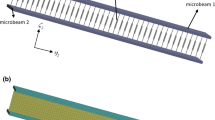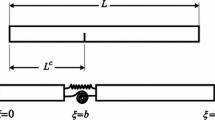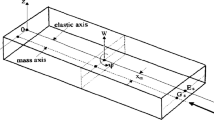Abstract
In this article, the nonlinear transverse vibration of an elastically connected double microbeam system carrying a moving particle is assessed based on the modified couple stress and non-classical Timoshenko beam theories. Hamilton’s principle is applied to develop the motion equations and corresponding boundary conditions, and the Galerkin method is used to solve these equations. The numerical study reveals that the nonlinear and modified couple stress theories predict a stiffer system than the linear and classical theories do. A parametric study is run to determine the different parameters’ influence like the aspect ratio, the stiffness modulus of the elastic layer and the velocity of the moving particle, on the dynamic response of the system. The results show that the aspect ratio has a significant effect on the dynamic response of the system, indicating that the classical theory cannot predict the dynamic behavior of micro-size beam systems. The elastic layer stiffness modulus and the velocity of the moving particle have considerable effects on the dynamic deflections of the double-microbeam system.
















Similar content being viewed by others
Availability of data and material
The datasets used and/or analyzed during the current study are available from the corresponding author on reasonable request.
References
Lun F-Y, Zhang P, Gao F-B, Jia H-G (2006) Design and fabrication of micro-optomechanical vibration sensor. Weixi Jiagong Jishu/Microfabr Technol 120:61–64
Mojahedi M, Moghimi Zand M, Ahmadian MT (2010) Static pull-in analysis of electrostatically actuated microbeams using homotopy perturbation method. Appl Math Model 34:1032–1041. https://doi.org/10.1016/j.apm.2009.07.013
Moghimi Zand M, Ahmadian MT (2009) Vibrational analysis of electrostatically actuated microstructures considering nonlinear effects. Commun Nonlinear Sci Numer Simul 14:1664–1678. https://doi.org/10.1016/j.cnsns.2008.05.009
Ahmadian MT, Borhan H, Esmailzadeh E (2009) RETRACTED: dynamic analysis of geometrically nonlinear and electrostatically actuated micro-beams. Commun Nonlinear Sci Numer Simul 14:1627–1645. https://doi.org/10.1016/j.cnsns.2008.01.006
Coutu RA, Kladitis PE, Starman LA, Reid JR (2004) A comparison of micro-switch analytic, finite element, and experimental results. Sens Actuators A Phys 115:252–258. https://doi.org/10.1016/j.sna.2004.03.019
Mahdavi MH, Farshidianfar A, Tahani M et al (2008) A more comprehensive modeling of atomic force microscope cantilever. Ultramicroscopy 109:54–60. https://doi.org/10.1016/j.ultramic.2008.08.003
Stölken JS, Evans AG (1998) A microbend test method for measuring the plasticity length scale. Acta Mater 46:5109–5115. https://doi.org/10.1016/S1359-6454(98)00153-0
McFarland AW, Colton JS (2005) Role of material microstructure in plate stiffness with relevance to microcantilever sensors. J Micromech Microeng 15:1060
Koiter WT (1969) Couple-stresses in the theory of elasticity, I and II. Philos Trans R Soc Lond B 67:17–44
Mindlin RD, Tiersten HF (1962) Effects of couple-stresses in linear elasticity. Arch Ration Mech Anal 11:415–448
Toupin RA (1962) Elastic materials with couple-stresses. Arch Ration Mech Anal 11:385–414
Yang F, Chong ACM, Lam DCC, Tong P (2002) Couple stress based strain gradient theory for elasticity. Int J Solids Struct 39:2731–2743. https://doi.org/10.1016/S0020-7683(02)00152-X
Khorshidi MA, Shariati M (2016) Free vibration analysis of sigmoid functionally graded nanobeams based on a modified couple stress theory with general shear deformation theory. J Braz Soc Mech Sci Eng 38:2607–2619
Zeighampour H, Beni YT (2014) Size-dependent vibration of fluid-conveying double-walled carbon nanotubes using couple stress shell theory. Phys E Low-dimens Syst Nanostruct 61:28–39
Bhattacharya S, Das D (2019) Free vibration analysis of bidirectional-functionally graded and double-tapered rotating micro-beam in thermal environment using modified couple stress theory. Compos Struct 215:471–492. https://doi.org/10.1016/j.compstruct.2019.01.080
Şimşek M (2010) Vibration analysis of a single-walled carbon nanotube under action of a moving harmonic load based on nonlocal elasticity theory. Phys E Low-dimens Syst Nanostruct 43:182–191. https://doi.org/10.1016/j.physe.2010.07.003
Kiani K (2010) Longitudinal and transverse vibration of a single-walled carbon nanotube subjected to a moving nanoparticle accounting for both nonlocal and inertial effects. Phys E Low-dimens Syst Nanostruct 42:2391–2401. https://doi.org/10.1016/j.physe.2010.05.021
Şimşek M (2011) Nonlocal effects in the forced vibration of an elastically connected double-carbon nanotube system under a moving nanoparticle. Comput Mater Sci 50:2112–2123. https://doi.org/10.1016/j.commatsci.2011.02.017
Hosseini Hashemi S, Bakhshi Khaniki H (2017) Dynamic behavior of multi-layered viscoelastic nanobeam system embedded in a viscoelastic medium with a moving nanoparticle. J Mech 33:559–575. https://doi.org/10.1017/jmech.2016.91
Hashemi SH, Khaniki HB (2018) Dynamic response of multiple nanobeam system under a moving nanoparticle. Alex Eng J 57:343–356. https://doi.org/10.1016/j.aej.2016.12.015
Rahmani O, Norouzi S, Golmohammadi H, Hosseini SAH (2017) Dynamic response of a double, single-walled carbon nanotube under a moving nanoparticle based on modified nonlocal elasticity theory considering surface effects. Mech Adv Mater Struct 24:1274–1291. https://doi.org/10.1080/15376494.2016.1227504
Şimşek M (2010) Dynamic analysis of an embedded microbeam carrying a moving microparticle based on the modified couple stress theory. Int J Eng Sci 48:1721–1732. https://doi.org/10.1016/j.ijengsci.2010.09.027
Jafari-Talookolaei RA, Abedi M, Şimşek M, Attar M (2016) Dynamics of a micro scale Timoshenko beam subjected to a moving micro particle based on the modified couple stress theory. J Vib Control 24:527–548. https://doi.org/10.1177/1077546316645237
Bakhshi Khaniki H, Hosseini-Hashemi S (2017) The size-dependent analysis of multilayered microbridge systems under a moving load/mass based on the modified couple stress theory. Eur Phys J Plus 132:200. https://doi.org/10.1140/epjp/i2017-11466-0
Asghari M, Kahrobaiyan MH, Ahmadian MT (2010) A nonlinear Timoshenko beam formulation based on the modified couple stress theory. Int J Eng Sci 48:1749–1761. https://doi.org/10.1016/j.ijengsci.2010.09.025
Hutchinson JR (2000) Shear coefficients for Timoshenko beam theory. J Appl Mech 68:87–92
Ma HM, Gao XL, Reddy JN (2008) A microstructure-dependent Timoshenko beam model based on a modified couple stress theory. J Mech Phys Solids 56:3379–3391. https://doi.org/10.1016/j.jmps.2008.09.007
Stojanović V, Kozić P (2015) Vibrations and stability of complex beam systems. Springer, Berlin
Şimşek M (2010) Non-linear vibration analysis of a functionally graded Timoshenko beam under action of a moving harmonic load. Compos Struct 92:2532–2546
Ansari R, Gholami R, Darabi MA (2012) A nonlinear Timoshenko beam formulation based on strain gradient theory. J Mech Mater Struct 7:195–211
Reddy JN (2011) Microstructure-dependent couple stress theories of functionally graded beams. J Mech Phys Solids 59:2382–2399
Funding
This research did not receive any specific grant from funding agencies in the public, commercial, or not-for-profit sectors.
Author information
Authors and Affiliations
Contributions
All authors of this manuscript have directly participated in the planning, execution and/or analysis of this study. Mostafa Hadian designed the study, performed the statistical analysis, interpreted the data and searched the literature. Keivan Torabi designed the study and interpreted the data. Shahram Hadian Jazi designed the study, performed the statistical analysis, interpreted the data and was a major contributor in writing the manuscript.
Corresponding author
Ethics declarations
Conflict of interest
The authors declare that they have no conflict of interest.
Additional information
Technical Editor: Pedro Manuel Calas Lopes Pacheco, D.Sc.
Publisher's Note
Springer Nature remains neutral with regard to jurisdictional claims in published maps and institutional affiliations.
Appendix
Appendix
The components of Eq. (29) are as follows:
and
where
Rights and permissions
About this article
Cite this article
Hadian, M., Torabi, K. & Hadian Jazi, S. Nonlinear vibration analysis of an elastically connected double-non-classical Timoshenko microbeam subject to moving particle based on the modified couple stress theory. J Braz. Soc. Mech. Sci. Eng. 42, 246 (2020). https://doi.org/10.1007/s40430-020-02336-z
Received:
Accepted:
Published:
DOI: https://doi.org/10.1007/s40430-020-02336-z




